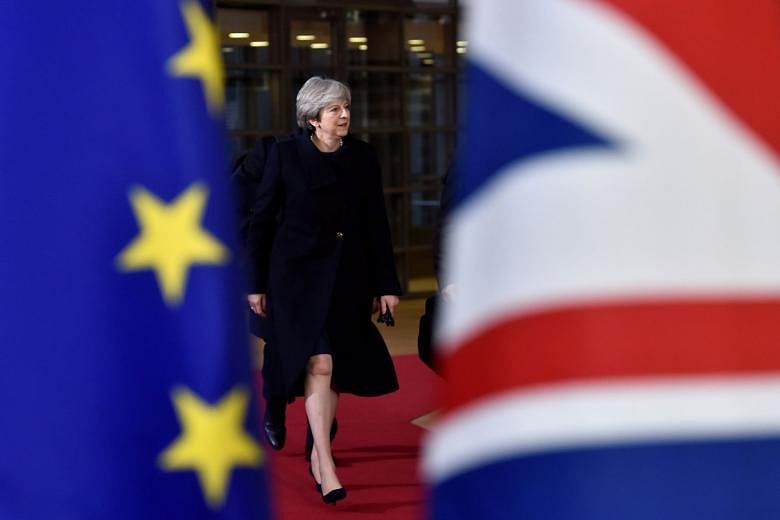There is more than a hint of desperation in news that Britain, an island nation in the Atlantic Ocean, might want to join the Trans-Pacific Partnership (TPP) trade deal. But rather than dismiss the idea out of hand, the TPP's 11 member nations should take its approach seriously, sending a signal of their ambition to turn the agreement into the world's most important trading bloc.
The idea that Britain might join the TPP seems odd. Begun in the late 2000s, the deal was designed by the United States to bring together 12 nations around the Americas and Asia, ranging from Canada and Mexico to Australia, Japan and Singapore. The pact suffered a near-death experience early last year, when President Donald Trump flounced out of it. The remaining 11 nations then resuscitated it, announcing a draft agreement in November. Yet, whichever way you look at it, the TPP was conceived as a way to bring together countries around Asia's Pacific rim - the clue, after all, is in the name - not European nations like Britain.
Its tentative signals of interest this week were bound up in the bad choices facing Prime Minister Theresa May post-Brexit. As Britain disentangles itself from the EU, it badly needs new trade deals. Some in Mrs May's government harbour romantic notions that it can transform into a global entrepot: a so-called Singapore-on-Thames.
This is fanciful. In truth, Britain's TPP hopes stem from a lack of alternatives. It is unwisely quitting the European Union, the world's largest trading bloc, and home to almost all of its major trading partners. The TPP cannot replace this. Britain trades roughly twice as much with tiny Ireland as it does with Japan, the biggest TPP economy. Yet the TPP could at least give Mrs May access to one of the world's other high-quality trade zones.
The idea of British entry comes with many obvious problems. The TPP is as yet officially unsigned; a final deal is expected only in a few months. More importantly, there is little clarity on Britain's terms of trade after Brexit, which will be finalised next year. Without knowing these details - on tariff levels, for instance - even tentative talks to enter are all but impossible.
Even so, there is no reason in theory why Britain could not join. TPP was designed to expand. Ms Deborah Elms, head of the Singapore-based Asia Trade Centre and a close TPP watcher, points to other potential applicants, including Colombia and South Korea. There is nothing in the rules to stop a European nation applying too.
British membership also would not change the fundamental character of the deal. Britain is the world's sixth-largest economy, but its trading ties with TPP members are relatively modest, so having it as a member would not be disruptive. Britain would also apply to join from a position of weakness, meaning the TPP's existing members could negotiate favourable terms.
British membership could even solve problems for some TPP members, especially those like Australia and Singapore, which want to strike bilateral deals with the UK after Brexit. Japan, now the TPP's effective leader, is also worried about the post-Brexit fate of companies like Nissan and Toyota, which have large factories in Britain. At the margin, having the British inside TPP could ease these problems.
All this does not mean a deal could happen. Any British entry would be long and complex. The legacy rules that Britain takes out of the EU, which will underpin the trade deal it must now strike with the 27-member bloc, may simply be incompatible with TPP membership.
There are also fraught regional issues to consider. China is not a member of TPP, but it might well dislike the idea of the pact expanding to include a European economy. Opposition from Beijing could alarm other TPP members. In the end, each existing TPP member could veto British membership for any number of reasons. Meanwhile, the bloc as a whole might decide to change the rules so that only Pacific nations are allowed.
Yet this final step would be a mistake, for two reasons.
First, TPP members still want to tempt the US back in. The odds of American re-entry under President Trump are zero. But a future president could look again. Crucially, they would need to demonstrate to the American people, and their representatives in Congress, that the US was signing a better agreement than the one Mr Trump rejected. Here, British membership, or the prospect of it, might help. Britain would be the second-biggest TPP economy, after Japan, and the bigger the deal becomes, the greater the trading benefits the US might see.
But the more important reason to take Britain's entreaties seriously is the ambition it would signal.
The TPP was designed by the US as the "gold standard" of global trade agreements and beacon for open commerce. America's departure badly dented that vision, but there is no reason why it cannot be rekindled without America.
The best way to do this would be to launch a bold TPP "phase 2" , with the aim of turning the pact into the planet's premier trade zone. Expanding the bloc's membership would be at the heart of this, both within Asia and beyond. If you want to hammer home the point that the Pacific's rising powers plan to remake the world economic order, inviting a declining Atlantic power to clamber aboard might not be a bad place to start.
- The writer is an associate professor of practice at the Lee Kuan Yew School of Public Policy, National University of Singapore. His new book, The Billionaire Raj, is published in July.

